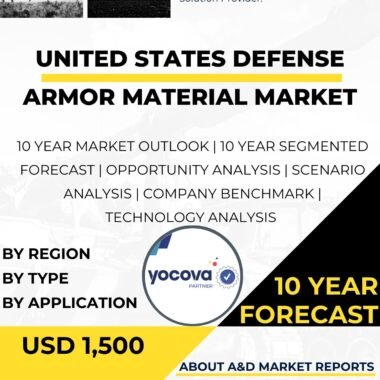Description
The United States Global Bulletproof Vests Market is an essential segment of the security and defense industry, catering to the growing demand for personal protective equipment. Bulletproof vests, also known as ballistic vests or body armor, are designed to safeguard individuals from ballistic threats, including bullets and shrapnel. This market has witnessed substantial growth due to escalating security concerns, the prevalence of firearms, and the need for enhanced personal safety across various sectors.
Bulletproof vests have evolved significantly over the years, with advancements in design, materials, and effectiveness. They serve multiple purposes and cater to diverse customer groups, including military personnel, law enforcement agencies, and civilians facing potentially life-threatening situations.
The market is primarily driven by increased security concerns, both domestically and internationally. Heightened awareness of the potential risks posed by terrorism, armed violence, and civil unrest has spurred demand for personal protection equipment like bulletproof vests. Law enforcement agencies, in particular, represent a significant market for these vests, given the inherent dangers associated with their line of duty. Officers require effective protective gear to minimize the risk of injury or fatality during confrontations.
Moreover, the military continues to prioritize the development of advanced body armor for soldiers. Lightweight yet highly effective ballistic vests are crucial to enhance troop survivability on the battlefield. These vests undergo rigorous testing to ensure they meet stringent standards for protection against various ballistic threats.
Civilian demand for bulletproof vests has also seen growth. Individuals in various professions, such as private security, journalism, and industries like mining, may require such protective gear to safeguard themselves in potentially hazardous environments. This expanding customer base reflects the broader applicability of bulletproof vests beyond traditional military and law enforcement sectors.
In terms of product segments, bulletproof vests can be categorized into soft armor and hard armor. Soft armor vests are constructed using flexible materials like Kevlar, Spectra, or Twaron, making them comfortable and suitable for law enforcement and civilian applications. On the other hand, hard armor vests incorporate rigid plates made of materials such as ceramic or steel, offering enhanced protection against high-velocity rounds. These are commonly used by the military and tactical units.
Concealable vests are designed to be worn discreetly under clothing, allowing law enforcement officers and security personnel to maintain a low profile while being protected. Tactical vests, primarily used by military and special operations personnel, provide ballistic protection and serve as platforms for carrying additional gear and equipment.
Technological advancements have significantly influenced the bulletproof vests market. Innovations in materials science have resulted in lighter yet stronger fibers, improving the overall effectiveness of these vests. Furthermore, designers have focused on enhancing comfort and mobility, ensuring that wearers can move with ease during critical situations.
Modular systems have become popular, enabling users to customize their vests with additional protective plates, pouches, and accessories to meet specific operational requirements. Some modern bulletproof vests even integrate sensors and communication systems, enhancing situational awareness and providing real-time data to the wearer.
Government regulations and standards, particularly those set by the National Institute of Justice (NIJ) in the United States, play a pivotal role in the market. These standards ensure that ballistic vests meet specific levels of protection and quality, giving consumers confidence in the products they choose for personal safety.
In conclusion, the United States Global Bulletproof Vests Market is a dynamic and expanding industry, driven by security concerns and technological innovations. The demand for advanced protective gear continues to grow across various sectors, underscoring the importance of this market in enhancing personal safety and security in an increasingly complex world.




